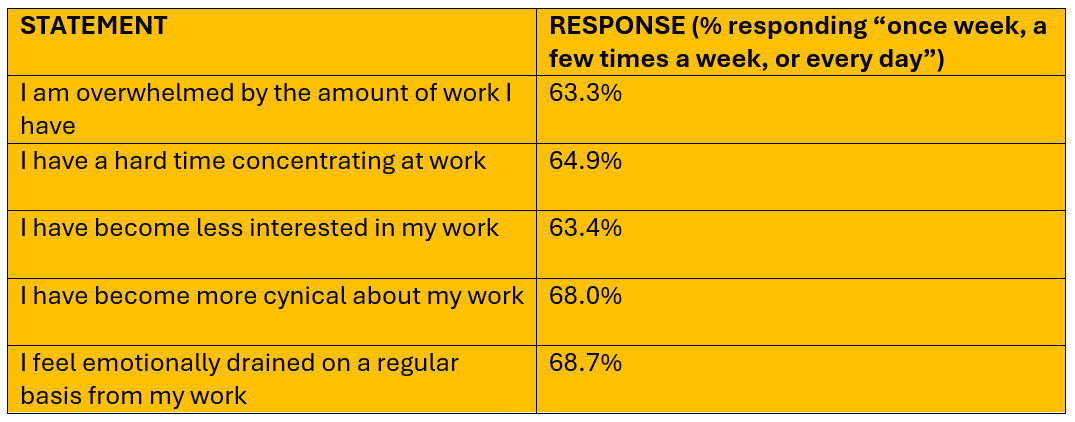Following a blueprint for building high-performing and engaged teams can help legal leaders address increased levels of stress, burnout, and disengagement among legal professionals, while promoting values alignment and fostering a human-centric leadership approach
In the wake of the pandemic and on the cusp of the generative AI (GenAI) revolution, people’s relationship with work has evolved, and chronic stress, burnout, and disengagement have reached new levels. Gallup recently reported that work engagement has reached a 10-year low, and we are in an era of work that has been dubbed the Great Detachment.
And my own research with American Law Media focusing on the legal profession supports these findings. To more clearly understand how frequently lawyers and legal professionals were experiencing different aspects of the three burnout dimensions, I created 17 statements and asked respondents to rate how frequently the statements applied to them. In all, 887 lawyers and legal professionals responded, and a small portion of the results are summarized in the chart below. It’s not that lawyers and legal professionals are experiencing some of these factors that is concerning — it’s the frequency.

For leaders of legal organizations to match this moment and continue to build teams and cultures that are both high-performing and engaged, they need to first understand four macro factors, which help explain some of the discontent.
FACTOR 1: The pandemic altered our collective perspective about work and life — While it may seem ages ago now, the pandemic was an upheaval event that impacted literally everyone on the planet. During this time, many people were scared, chronically stressed, overwhelmed, and frustrated. Upheaval events such as this amplify people’s search for meaning and purpose through post-traumatic growth.
FACTOR 2: Uncertainty & instability are here to stay — People analytics leader, David Green, notes that: “Companies are confronted with a series of organizational shifts that have significant implications for structures, processes, and people. These include complex questions around finding an optimal balance between in-person and remote work, building new organizational capabilities in the face of challenging (and changing) workforce demographics and talent gaps, and focusing on developing a healthy, inclusive, and thriving company culture.”
These types of changes — both large and small, acute and ongoing — create psychological pressure and strain in unexpected ways and continue to drive stress and exhaustion. Volatility, change, and uncertainty will continue to define work for the foreseeable future; however, change and instability often strengthen workers’ resolve to find and advocate for well-being, meaning, and work-life balance.
FACTOR 3: A technology-enabled future will require a human-centric leadership approach — GenAI is in the process of transforming certain aspects of the legal profession, and this will only evolve as the technology becomes more sophisticated and legal organizations learn how best to use it. Legal leaders must now know how to lead in a way that promotes community, creativity, communication, teamwork, and other human-focused qualities that GenAI tools will have a difficult time replicating.
FACTOR 4: Leaders need to incorporate practices that amplify meaningful work and promote an alignment of values — People want a sense of purpose and meaning in their work, and legal leaders need to be able to connect the dots to this higher level of aspiration. While meaning and values alignment are important generally, they are critical must-haves for younger Millennials and Gen Z workers.
Great leadership has always been needed for companies and firms to grow and thrive, but the how of going about it has changed. To be able to effectively lead as the legal landscape continues to evolve, leaders need a blueprint that will give them the tools to: i) address the root causes of both stress and high-performance; ii) build thriving teams that stay engaged, connected, and inspired; and iii) help their teams adapt to and navigate change, complexity, and uncertainty. Collectively, I call this approach Lead Well and have created five mindsets for legal leaders to practice:
-
-
- Mindset #1 — Prioritize sticky recognition & mattering
- Mindset #2 — Amplify ABC needs (Autonomy, Belonging & Challenge)
- Mindset #3 — Create workload sustainability
- Mindset #4 — Build systemic stress resilience
- Mindset #5 — Promote Alignment of values & meaning
-
The TNTs (Tiny Noticeable Things) that help
What I have discovered is that the skills, tools, and frameworks underpinning the Lead Well concept typically fall into one of two buckets: good teaming practices and good human practices. And there are some tiny, noticeable things that can get help, including:
Say a thank you “plus” — When you acknowledge someone, add an extra sentence to specify the strength or behavior you saw in them that led to the good outcome. This creates sticky recognition & mattering and also amplifies the B in ABC needs.
Hold a debrief — When a legal matter ends, or at key inflection points, pause to debrief by checking in with the team and asking what’s working or not working. This practice increases team resilience and can also help with workload sustainability by giving people clarity.
Conduct a meetings audit — Good meetings have an explicitly stated goal, an agenda, a default standard length of 15 to 30 minutes, and a meeting facilitator. Better meeting practices often lead to fewer or shorter meetings, which also helps workload sustainability.
Get on the same page — Effective teams are consistently on the same page about direction, priorities, and roles. Your team should regularly discuss and have a clear understanding of what success looks like and what the project’s top priorities are, while delineating clear roles. Teams can then take control of and feel ownership over their actions, which enhances both the A and C of the ABC needs.
Talk about impact — Employees need a clear line of sight between what they do and the impact it has on other people’s lives. Lawyers wade into the toughest challenges that business and society face, yet the extraordinary impact isn’t often discussed. Talking about the impact of work being done was found to be the pathway most strongly associated with achieving meaningful work.
The traditional model of leadership development in the legal profession starts way too late in a lawyer’s career and typically does not account for teaching skills associated with building strong teams and the psychological factors associated with motivating and encouraging others. Nor does it help legal organization leaders better understand the factors that underpin a great culture, and which factors make people want to stay long-term. The good news is that all of this is teachable and science based — ultimately, the stronger your team, the more you will have time to focus on your legal practice.
You can find more about Paula Davis’s recently published second book, Lead Well: Five Mindsets to Engage, Retain, & Inspire Your Team, here







